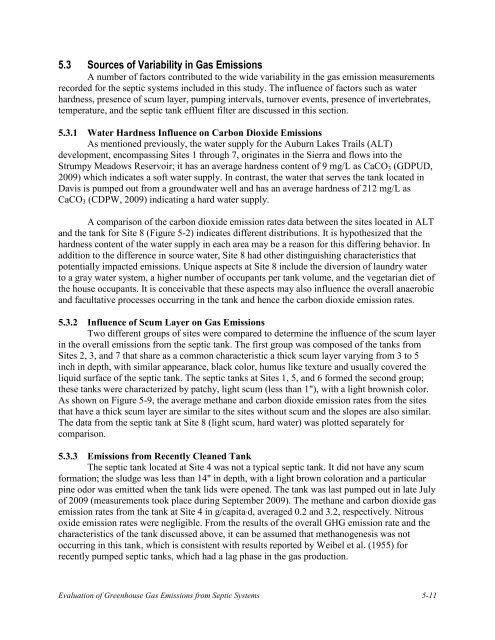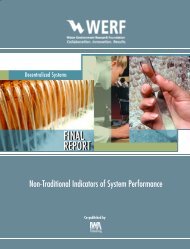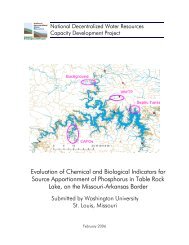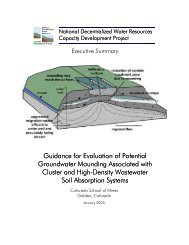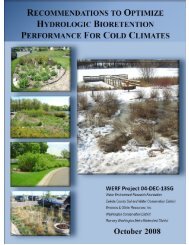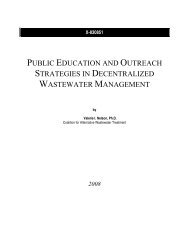Evaluation of Greenhouse Gas Emissions from Septic ... - Geoflow
Evaluation of Greenhouse Gas Emissions from Septic ... - Geoflow
Evaluation of Greenhouse Gas Emissions from Septic ... - Geoflow
Create successful ePaper yourself
Turn your PDF publications into a flip-book with our unique Google optimized e-Paper software.
5.3 Sources <strong>of</strong> Variability in <strong>Gas</strong> <strong>Emissions</strong>A number <strong>of</strong> factors contributed to the wide variability in the gas emission measurementsrecorded for the septic systems included in this study. The influence <strong>of</strong> factors such as waterhardness, presence <strong>of</strong> scum layer, pumping intervals, turnover events, presence <strong>of</strong> invertebrates,temperature, and the septic tank effluent filter are discussed in this section.5.3.1 Water Hardness Influence on Carbon Dioxide <strong>Emissions</strong>As mentioned previously, the water supply for the Auburn Lakes Trails (ALT)development, encompassing Sites 1 through 7, originates in the Sierra and flows into theStrumpy Meadows Reservoir; it has an average hardness content <strong>of</strong> 9 mg/L as CaCO 3 (GDPUD,2009) which indicates a s<strong>of</strong>t water supply. In contrast, the water that serves the tank located inDavis is pumped out <strong>from</strong> a groundwater well and has an average hardness <strong>of</strong> 212 mg/L asCaCO 3 (CDPW, 2009) indicating a hard water supply.A comparison <strong>of</strong> the carbon dioxide emission rates data between the sites located in ALTand the tank for Site 8 (Figure 5-2) indicates different distributions. It is hypothesized that thehardness content <strong>of</strong> the water supply in each area may be a reason for this differing behavior. Inaddition to the difference in source water, Site 8 had other distinguishing characteristics thatpotentially impacted emissions. Unique aspects at Site 8 include the diversion <strong>of</strong> laundry waterto a gray water system, a higher number <strong>of</strong> occupants per tank volume, and the vegetarian diet <strong>of</strong>the house occupants. It is conceivable that these aspects may also influence the overall anaerobicand facultative processes occurring in the tank and hence the carbon dioxide emission rates.5.3.2 Influence <strong>of</strong> Scum Layer on <strong>Gas</strong> <strong>Emissions</strong>Two different groups <strong>of</strong> sites were compared to determine the influence <strong>of</strong> the scum layerin the overall emissions <strong>from</strong> the septic tank. The first group was composed <strong>of</strong> the tanks <strong>from</strong>Sites 2, 3, and 7 that share as a common characteristic a thick scum layer varying <strong>from</strong> 3 to 5inch in depth, with similar appearance, black color, humus like texture and usually covered theliquid surface <strong>of</strong> the septic tank. The septic tanks at Sites 1, 5, and 6 formed the second group;these tanks were characterized by patchy, light scum (less than 1"), with a light brownish color.As shown on Figure 5-9, the average methane and carbon dioxide emission rates <strong>from</strong> the sitesthat have a thick scum layer are similar to the sites without scum and the slopes are also similar.The data <strong>from</strong> the septic tank at Site 8 (light scum, hard water) was plotted separately forcomparison.5.3.3 <strong>Emissions</strong> <strong>from</strong> Recently Cleaned TankThe septic tank located at Site 4 was not a typical septic tank. It did not have any scumformation; the sludge was less than 14" in depth, with a light brown coloration and a particularpine odor was emitted when the tank lids were opened. The tank was last pumped out in late July<strong>of</strong> 2009 (measurements took place during September 2009). The methane and carbon dioxide gasemission rates <strong>from</strong> the tank at Site 4 in g/capita·d, averaged 0.2 and 3.2, respectively. Nitrousoxide emission rates were negligible. From the results <strong>of</strong> the overall GHG emission rate and thecharacteristics <strong>of</strong> the tank discussed above, it can be assumed that methanogenesis was notoccurring in this tank, which is consistent with results reported by Weibel et al. (1955) forrecently pumped septic tanks, which had a lag phase in the gas production.<strong>Evaluation</strong> <strong>of</strong> <strong>Greenhouse</strong> <strong>Gas</strong> <strong>Emissions</strong> <strong>from</strong> <strong>Septic</strong> Systems 5-11


